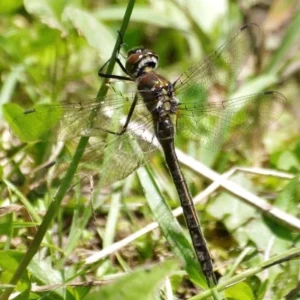Note: All links leave to external sites.
Greetings, BugFans,
The dragonfly season is starting – migrant Common Green Darners and Variegated Meadowhawks are filtering into the state, and visions of sugarplums (in the form of Chalk-fronted Corporals, Baskettails, and Eastern Forktails) are dancing in our heads! June will see the first of the Emeralds (family Corduliidae).
Also called Green-eyed Skimmers (though the name Skimmer belongs more properly to a different family, Libellulidae), the Emerald family is a large and varied one (about 50 species in North America and 400 worldwide) that includes the bog haunters, emeralds, baskettails, sundragons, and shadowdragons. Corduliids are found worldwide, and as a group, their ranges tend to be northerly.
They are medium to large (1 ½” to 3” long) dragonflies, and although they may be dark in coloration, many have metallic markings on their thorax and striking green eyes that touch on the top of their heads. Many species have a pale ring between the second and third abdominal segments. When they perch (which is not often enough for dragonfly photographers), they tend to perch vertically, hanging from vegetation at a 45 degree angle.
Every spring, the BugLady takes lots of pictures of the very spiffy Racket-tailed Emerald (Dorocordulia libera), a species found commonly in the northeast quadrant of the continent. She doesn’t see the larger, American Emerald (Cordulia shurtleffii) nearly as often – it’s more common near bogs, sedge marshes, forested lakes and ponds, and fens “Up North” and across much of Canada and the northern US. Some American Emeralds have (slightly) flared abdomens, like the Racket-tailed Emerald does, but the yellow band at the top of the Racket-tail’s abdomen is thick and uneven compared to the American Emerald’s thin ring. American Emeralds may resemble and overlap in size with some of the Striped Emeralds in the genus Somatochlora.
Adults eat soft-bodied insects that they grab out of the air, from mosquitoes to butterflies to mayflies to royal ants to recently-emerged dragonflies and damselflies. They forage in woodland openings and edges and sometimes, early in the season, mingle with swarms of baskettails. Paulson (Dragonflies and Damselflies of the East) reports that the American Emerald “sometimes hovers among plants in an effort to flush prey, often successful.” As befits a northern species, they are more active in cooler temperatures.
Kurt Mead, in Dragonflies of the North Woods, tells us to “Look for the males’ ‘dart and hover,’ ‘dart and hover’ behavior as they patrol their shifting territories along boggy edges of small lakes and ponds.” After mating, a longish process carried out partially in flight, Mead says that “the female taps the surface of the water with her abdomen when laying eggs, often among sedges and other emergent vegetation.”
The sturdy, hairy, aquatic naiads are “sprawlers,” hiding in the mud and under the debris trapped in their hairs, and ambushing their prey – scuds (freshwater shrimp), mosquito and midge larvae, mayfly nymphs, and the occasional tiny fish and tadpole – as it passes by. They can tolerate pretty cold water, but in cold water they need more than one summer to mature. They emerge to shed their final skin at night. Here’s a teneral – a recently emerged adult – that has the reddish-brown eyes typical of a young emerald.
The BugLady was curious about the American Emerald’s species name shurtleffii (ah – the etymology of entomology!), so she did a little digging. The species was described by the renowned entomologist Samuel Scudder in 1866. Scudder named it after a young physician named Carleton Atwood Shurtleff (1840 to 1864), a polymath whose interests included botany (native orchids) and entomology (he studied insect wing venation). Shurtleff’s parents sent his collections and papers to the Boston Society of Natural History after his death in 1864 “from a disease contracted at the siege of Vicksburg.” Scudder read a paper by Shurtleff posthumously at a Society meeting and praised his achievements, and later immortalized him in a dragonfly’s name.
Carpe diem (or as the BugLady’s t-shirt says, “Carpe Insectum.”)
The BugLady
